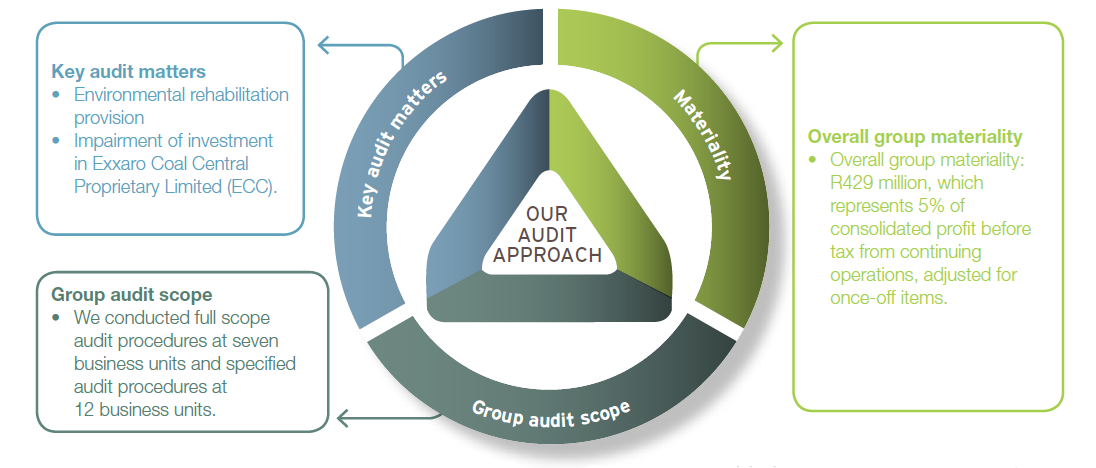Integrated report 2019

Exxaro Resources Limited
Group and company annual financial statements
for the year ended 31 December 2019
2.5 |
INDEPENDENT AUDITOR’S REPORTTO THE SHAREHOLDERS OF EXXARO RESOURCES LIMITEDREPORT ON THE AUDIT OF THE CONSOLIDATED AND SEPARATE FINANCIAL STATEMENTSOur opinion In our opinion, the consolidated and separate financial statements present fairly, in all material respects, the consolidated and separate financial position of Exxaro Resources Limited (the company) and its subsidiaries (together the group) as at 31 December 2019, and its consolidated and separate financial performance and its consolidated and separate cash flows for the year then ended in accordance with International Financial Reporting Standards and the requirements of the Companies Act of South Africa. What we have audited Exxaro Resources Limited’s consolidated and separate financial statements comprise:
BASIS FOR OPINIONWe conducted our audit in accordance with International Standards on Auditing (ISA). Our responsibilities under those standards are further described in the Auditor’s responsibilities for the audit of the consolidated and separate financial statements section of our report. We believe that the audit evidence we have obtained is sufficient and appropriate to provide a basis for our opinion. Independence We are independent of the group in accordance with sections 290 and 291 of the Independent Regulatory Board for Auditors’ Code of Professional Conduct for Registered Auditors (revised January 2018), parts 1 and 3 of the Independent Regulatory Board for Auditors’ Code of Professional Conduct for Registered Auditors (revised November 2018) (together the IRBA Codes) and other independence requirements applicable to performing audits of financial statements in South Africa. We have fulfilled our other ethical responsibilities, as applicable, in accordance with the IRBA Codes and in accordance with other ethical requirements applicable to performing audits in South Africa. The IRBA Codes are consistent with the corresponding sections of the International Ethics Standards Board for Accountants’ Code of Ethics for Professional Accountants and the International Ethics Standards Board for Accountants’ International Code of Ethics for Professional Accountants (including International Independence Standards) respectively. OUR AUDIT APPROACHOverview 
As part of designing our audit, we determined materiality and assessed the risks of material misstatement in the consolidated and separate financial statements. In particular, we considered where the directors made subjective judgements; for example, in respect of significant accounting estimates that involved making assumptions and considering future events that are inherently uncertain. As in all of our audits, we also addressed the risk of management override of internal controls, including among other matters, consideration of whether there was evidence of bias that represented a risk of material misstatement due to fraud. MaterialityThe scope of our audit was influenced by our application of materiality. An audit is designed to obtain reasonable assurance whether the financial statements are free from material misstatement. Misstatements may arise due to fraud or error. They are considered material if individually or in aggregate, they could reasonably be expected to influence the economic decisions of users taken on the basis of the consolidated financial statements. Based on our professional judgement, we determined certain quantitative thresholds for materiality, including the overall group materiality for the consolidated financial statements as a whole as set out in the table below. These, together with qualitative considerations, helped us to determine the scope of our audit and the nature, timing and extent of our audit procedures and to evaluate the effect of misstatements, both individually and in aggregate on the financial statements as a whole.
How we tailored our group audit scope We tailored the scope of our audit in order to perform sufficient work to enable us to provide an opinion on the consolidated financial statements as a whole, taking into account the structure of the group, the accounting processes and controls, and the industry in which the group operates. Financially significant business units were identified based on scoping benchmarks such as the business unit’s contribution to key financial statement line items (consolidated profit before consolidated tax, consolidated revenue and consolidated total assets) and the risk associated with the business unit. We conducted full scope audit procedures at seven financially significant business units and performed specified audit procedures at a further 12 business units in order to obtain sufficient appropriate audit evidence over the consolidated numbers. In establishing the overall approach to the group audit, we determined the type of work that needed to be performed by us, as the group engagement team, component auditors from other PwC network firms and non-PwC firms operating under our instruction. Where the work was performed by component auditors, we determined the level of involvement we needed to have in the audit work at those components to be able to conclude whether sufficient appropriate audit evidence has been obtained as a basis for our opinion on the consolidated financial statements as a whole. The group engagement team performed audit procedures, among others, over the company financial statements, the consolidation process, financial statement disclosure and significant accounting positions taken by the group. Risk assessment analytics were performed for non-significant entities. KEY AUDIT MATTERSKey audit matters are those matters that, in our professional judgement, were of most significance in our audit of the consolidated and separate financial statements of the current period. These matters were addressed in the context of our audit of the consolidated and separate financial statements as a whole, and in forming our opinion thereon, and we do not provide a separate opinion on these matters.
OTHER INFORMATIONThe directors are responsible for the other information. The other information comprises the information included in the document titled “Exxaro Resources Limited group and company annual financial statements for the year ended 31 December 2019”, which includes the certificate by the group company secretary, the report of the directors and the audit committee report as required by the Companies Act of South Africa, and in the document titled “Exxaro Resources Limited integrated report 2019”. The other information does not include the consolidated or the separate financial statements and our auditor’s report thereon. Our opinion on the consolidated and separate financial statements does not cover the other information and we do not express an audit opinion or any form of assurance conclusion thereon. In connection with our audit of the consolidated and separate financial statements, our responsibility is to read the other information identified above and, in doing so, consider whether the other information is materially inconsistent with the consolidated and separate financial statements or our knowledge obtained in the audit, or otherwise appears to be materially misstated. If, based on the work we have performed, we conclude that there is a material misstatement of this other information, we are required to report that fact. We have nothing to report in this regard. RESPONSIBILITIES OF THE DIRECTORS FOR THE CONSOLIDATED AND SEPARATE FINANCIAL STATEMENTSThe directors are responsible for the preparation and fair presentation of the consolidated and separate financial statements in accordance with International Financial Reporting Standards and the requirements of the Companies Act of South Africa, and for such internal control as the directors determine is necessary to enable the preparation of consolidated and separate financial statements that are free from material misstatement, whether due to fraud or error. In preparing the consolidated and separate financial statements, the directors are responsible for assessing the group and the company’s ability to continue as a going concern, disclosing, as applicable, matters related to going concern and using the goingconcern basis of accounting unless the directors either intend to liquidate the group and/or the company or to cease operations, or have no realistic alternative but to do so. AUDITOR’S RESPONSIBILITIES FOR THE AUDIT OF THE CONSOLIDATED AND SEPARATE FINANCIAL STATEMENTSOur objectives are to obtain reasonable assurance about whether the consolidated and separate financial statements as a whole are free from material misstatement, whether due to fraud or error, and to issue an auditor’s report that includes our opinion. Reasonable assurance is a high level of assurance, but is not a guarantee that an audit conducted in accordance with ISA will always detect a material misstatement when it exists. Misstatements can arise from fraud or error and are considered material if, individually or in the aggregate, they could reasonably be expected to influence the economic decisions of users taken on the basis of these consolidated and separate financial statements. As part of an audit in accordance with ISA, we exercise professional judgement and maintain professional scepticism throughout the audit. We also:
We communicate with the directors regarding, among other matters, the planned scope and timing of the audit and significant audit findings, including any significant deficiencies in internal control that we identify during our audit. We also provide the directors with a statement that we have complied with relevant ethical requirements regarding independence, and to communicate with them all relationships and other matters that may reasonably be thought to bear on our independence, and where applicable, related safeguards. From the matters communicated with the directors, we determine those matters that were of most significance in the audit of the consolidated and separate financial statements of the current period and are therefore the key audit matters. We describe these matters in our auditor’s report unless law or regulation precludes public disclosure about the matter or when, in extremely rare circumstances, we determine that a matter should not be communicated in our report because the adverse consequences of doing so would reasonably be expected to outweigh the public interest benefits of such communication. REPORT ON OTHER LEGAL AND REGULATORY REQUIREMENTSIn terms of the IRBA Rule published in Government Gazette Number 39475 dated 4 December 2015, we report that PricewaterhouseCoopers Inc has been the auditor of Exxaro Resources Limited for nine years. PricewaterhouseCoopers Inc Waterfall City 20 April 2020 |
||||||||||||||||||||||||||||||||||